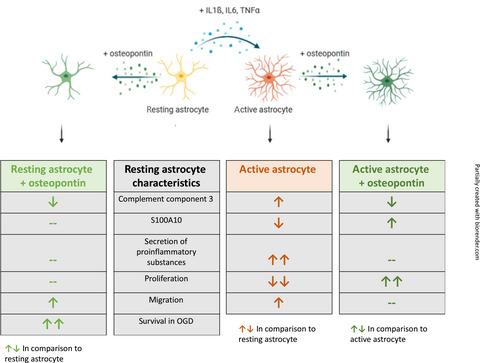当前位置:
X-MOL 学术
›
J. Neurosci. Res.
›
论文详情
Our official English website, www.x-mol.net, welcomes your
feedback! (Note: you will need to create a separate account there.)
Osteopontin regulates proliferation, migration, and survival of astrocytes depending on their activation phenotype
Journal of Neuroscience Research ( IF 2.9 ) Pub Date : 2021-09-12 , DOI: 10.1002/jnr.24954 Sabine Ulrike Vay 1 , Daniel Navin Olschewski 1 , Helena Petereit 1 , Felix Lange 1 , Nilufar Nazarzadeh 1 , Elena Gross 1 , Monika Rabenstein 1 , Stefan Johannes Blaschke 1, 2 , Gereon Rudolf Fink 1, 2 , Michael Schroeter 1, 2 , Maria Adele Rueger 1, 2
Journal of Neuroscience Research ( IF 2.9 ) Pub Date : 2021-09-12 , DOI: 10.1002/jnr.24954 Sabine Ulrike Vay 1 , Daniel Navin Olschewski 1 , Helena Petereit 1 , Felix Lange 1 , Nilufar Nazarzadeh 1 , Elena Gross 1 , Monika Rabenstein 1 , Stefan Johannes Blaschke 1, 2 , Gereon Rudolf Fink 1, 2 , Michael Schroeter 1, 2 , Maria Adele Rueger 1, 2
Affiliation

|
The glycoprotein osteopontin is highly upregulated in central nervous system (CNS) disorders such as ischemic stroke. Osteopontin regulates cell growth, cell adhesion, homeostasis, migration, and survival of various cell types. Accordingly, osteopontin is considered an essential regulator of regeneration and repair in the ischemic milieu. Astrocytes are the most abundant cells in the CNS and play significant roles in health and disease. Astrocytes are involved in homeostasis, promote neuroprotection, and regulate synaptic plasticity. Upon activation, astrocytes may adopt different phenotypes, termed A1 and A2. The direct effects of osteopontin on astrocytes, especially in distinct activation states, are yet unknown. The current study aimed to elucidate the impact of osteopontin on resting and active astrocytes. We established an inflammatory in vitro model of activated (A1) primary astrocytes derived from neonatal wistar rats by exposure to a distinct combination of proinflammatory cytokines. To model ischemic stroke in vitro, astrocytes were subjected to oxygen and glucose deprivation (OGD) in the presence or absence of osteopontin. Osteopontin modulated the activation phenotype by attenuating A1- and restoring A2-marker expression without compromising the active astrocytes’ immunocompetence. Osteopontin promoted the proliferation of active and the migration of resting astrocytes. Following transient OGD, osteopontin mitigated the delayed ongoing death of primary astrocytes, promoting their survival. Data suggest that osteopontin differentially regulates essential functions of resting and active astrocytes and confirm a significant regulatory role of osteopontin in an in vitro ischemia model. Furthermore, the data suggest that osteopontin constitutes a promising target for experimental therapies modulating neuroregeneration and repair.
中文翻译:

骨桥蛋白根据其活化表型调节星形胶质细胞的增殖、迁移和存活
糖蛋白骨桥蛋白在缺血性中风等中枢神经系统 (CNS) 疾病中高度上调。骨桥蛋白调节各种细胞类型的细胞生长、细胞粘附、体内平衡、迁移和存活。因此,骨桥蛋白被认为是缺血环境中再生和修复的重要调节剂。星形胶质细胞是中枢神经系统中最丰富的细胞,在健康和疾病中发挥着重要作用。星形胶质细胞参与体内平衡、促进神经保护和调节突触可塑性。激活后,星形胶质细胞可能采用不同的表型,称为 A1 和 A2。骨桥蛋白对星形胶质细胞的直接影响,尤其是在不同的激活状态下,尚不清楚。目前的研究旨在阐明骨桥蛋白对静息和活动星形胶质细胞的影响。我们建立了炎症通过暴露于不同的促炎细胞因子组合而衍生自新生 wistar 大鼠的活化 (A1) 原代星形胶质细胞的体外模型。在体外模拟缺血性中风,星形胶质细胞在存在或不存在骨桥蛋白的情况下进行氧和葡萄糖剥夺(OGD)。骨桥蛋白通过减弱 A1 和恢复 A2 标志物的表达来调节活化表型,而不损害活性星形胶质细胞的免疫能力。骨桥蛋白促进活性星形胶质细胞的增殖和静息星形胶质细胞的迁移。在短暂的 OGD 之后,骨桥蛋白减轻了原发性星形胶质细胞的延迟持续死亡,促进了它们的存活。数据表明,骨桥蛋白差异调节静息和活动星形胶质细胞的基本功能,并证实骨桥蛋白在体外具有显着的调节作用缺血模型。此外,数据表明骨桥蛋白构成了调节神经再生和修复的实验疗法的有希望的靶标。
更新日期:2021-09-12
中文翻译:

骨桥蛋白根据其活化表型调节星形胶质细胞的增殖、迁移和存活
糖蛋白骨桥蛋白在缺血性中风等中枢神经系统 (CNS) 疾病中高度上调。骨桥蛋白调节各种细胞类型的细胞生长、细胞粘附、体内平衡、迁移和存活。因此,骨桥蛋白被认为是缺血环境中再生和修复的重要调节剂。星形胶质细胞是中枢神经系统中最丰富的细胞,在健康和疾病中发挥着重要作用。星形胶质细胞参与体内平衡、促进神经保护和调节突触可塑性。激活后,星形胶质细胞可能采用不同的表型,称为 A1 和 A2。骨桥蛋白对星形胶质细胞的直接影响,尤其是在不同的激活状态下,尚不清楚。目前的研究旨在阐明骨桥蛋白对静息和活动星形胶质细胞的影响。我们建立了炎症通过暴露于不同的促炎细胞因子组合而衍生自新生 wistar 大鼠的活化 (A1) 原代星形胶质细胞的体外模型。在体外模拟缺血性中风,星形胶质细胞在存在或不存在骨桥蛋白的情况下进行氧和葡萄糖剥夺(OGD)。骨桥蛋白通过减弱 A1 和恢复 A2 标志物的表达来调节活化表型,而不损害活性星形胶质细胞的免疫能力。骨桥蛋白促进活性星形胶质细胞的增殖和静息星形胶质细胞的迁移。在短暂的 OGD 之后,骨桥蛋白减轻了原发性星形胶质细胞的延迟持续死亡,促进了它们的存活。数据表明,骨桥蛋白差异调节静息和活动星形胶质细胞的基本功能,并证实骨桥蛋白在体外具有显着的调节作用缺血模型。此外,数据表明骨桥蛋白构成了调节神经再生和修复的实验疗法的有希望的靶标。











































 京公网安备 11010802027423号
京公网安备 11010802027423号